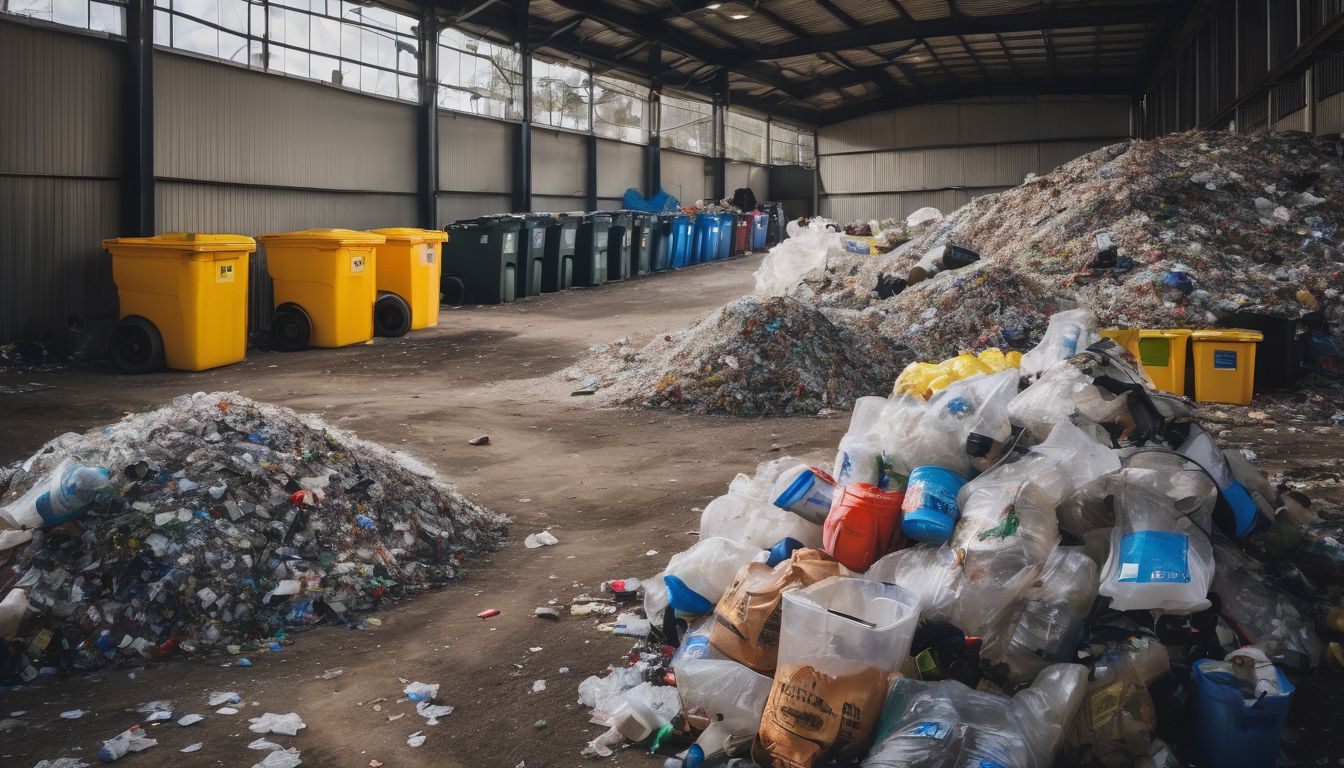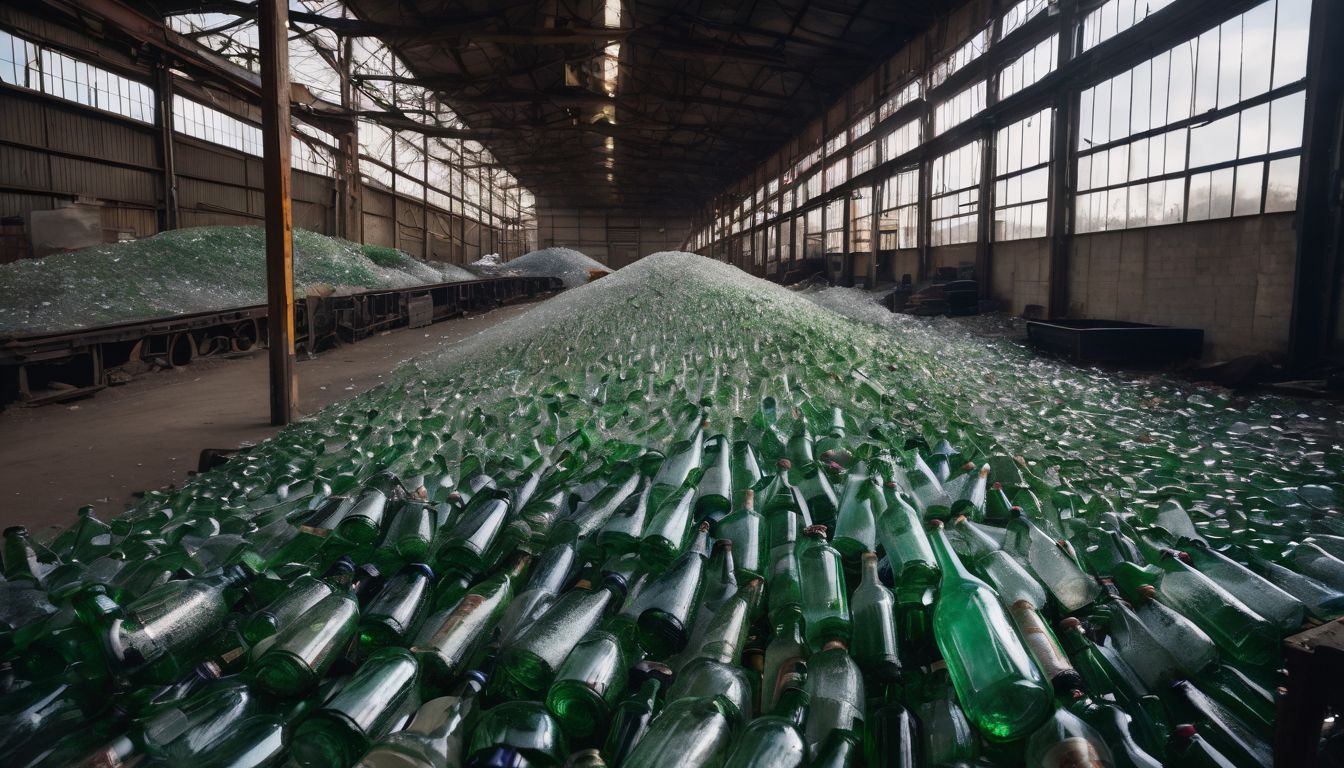Every day, we’re reminded of the urgent need to save energy and protect our planet. It’s a fact that recycling one aluminium can save enough energy to run a TV for three hours! This blog post will delve into how your everyday recycling efforts directly contribute to significant energy conservation.
Let’s discover the power of recycling together.
Key Takeaways
- Recycling different materials, such as paper, plastics, glass, and aluminum, can save a substantial amount of energy compared to producing new products from raw resources.
- By recycling one ton of glass we conserve enough energy to power 10 gallons of oil; similarly, aluminum recycling saves 95% of the energy needed for new production.
- Reducing waste through recycling significantly cuts down the amount sent to landfills and conserves natural resources like trees and minerals.
- The process of reusing materials in recycling leads to decreased demand for energy – intensive manufacturing processes that contribute to carbon emissions.
- Embracing the habit of recycling supports environmental sustainability by reducing our carbon footprint and promoting a circular economy.
Understanding Recycling and its Importance
Recycling is the process of converting waste materials into reusable products to prevent them from being disposed in landfills or incinerated. It helps to conserve natural resources, reduce pollution and save energy.
Definition of recycling
Recycling transforms used materials into new products, preventing the waste of potentially useful substances. This process conserves natural resources and energy by reducing the need for raw material extraction and processing.
When a recycled item completes the cycle from being discarded to reused, it helps reduce greenhouse gas emissions that would otherwise result from manufacturing new products.
This eco-friendly practice plays a critical role in sustainable living by managing waste effectively and promoting environmental sustainability. It ensures valuable material doesn’t end up in landfills where it takes years to decompose, if at all.
Up next, you’ll discover how everyday items like paper, plastics, glass, and aluminum can embark on this transformative journey through recycling.
Benefits of recycling
When considering the impact of recycling, it’s essential to acknowledge the significant benefits it brings to energy conservation and environmental sustainability. Recycling various materials such as paper, plastics, glass, and aluminum leads to a reduction in waste production and minimises the need for manufacturing new products from raw materials.
This process directly contributes to conserving natural resources, decreasing carbon emissions, and promoting a circular economy focused on renewable resources. By engaging in eco-friendly initiatives like recycling, individuals play an active role in reducing their carbon footprint while supporting conservation practices that are crucial for sustainable energy management.
Additionally, embracing recycling as part of waste management efforts not only encourages energy efficiency but also fosters green technology innovations. Through resource conservation and waste reduction strategies enabled by recycling activities, individuals contribute towards creating a more environmentally friendly world with fewer negative effects on our planet’s ecosystems.
Types of Materials that can be Recycled
Recycling encompasses a wide range of materials, from paper and plastics to glass and aluminum. Each type of material requires different processes for recycling and has its own environmental impact.
Paper
Paper recycling is a crucial part of energy conservation. By recycling paper, we save trees and reduce the energy needed to produce new paper from virgin material. Old newspapers, office paper, and cardboard can be recycled into new products, lowering the demand for fresh resources and lessening the environmental impact.
When paper is recycled, it not only conserves energy but also reduces landfill waste. The process of reusing old paper fibres saves about 65% of the energy required to make new paper from raw materials.
This eco-friendly initiative significantly contributes to reducing carbon emissions while supporting renewable energy and environmental impact efforts.
Plastics
Plastics play a significant role in our daily lives, from packaging to household items. Recycling plastics conserves energy and reduces the need for new raw materials, thus lessening the environmental impact of plastic production.
When plastic is recycled, it saves around 88% of the energy required to produce new plastics from raw materials like oil or natural gas. By recycling plastics, we contribute to ecofriendly initiatives by reducing energy consumption and minimising our carbon footprint.
Considering the environmental benefits and energy conservation achieved through recycling plastics, it’s essential to understand how other materials also contribute to these efforts.
Glass
Glass is an essential material that can be recycled to conserve energy and reduce waste. When glass is recycled, it saves raw materials and decreases the energy needed to produce new glass products.
Recycling one ton of glass reduces carbon emissions by around 300 kilograms as compared to manufacturing new glass. By recycling glass bottles and jars, we save resources and reduce the strain on natural reserves.
Recycling glass not only conserves energy but also has environmental benefits, contributing to a cleaner planet with fewer greenhouse gas emissions. Additionally, when we recycle glass packaging, we reduce the amount of waste sent to landfills which helps in preserving our environment for future generations.
Aluminum
Aluminium recycling is vital for conserving energy. Recycling aluminium saves about 90% of the energy needed to make new aluminium from raw materials, making it one of the most energy-efficient materials to recycle.
When recycled, aluminium can be used again and again without any loss in quality or strength. This process reduces the need for mining and extraction, cutting down on both energy usage and environmental impact.
By harnessing the benefits of aluminium recycling, we contribute significantly to conservation efforts, reducing our reliance on non-renewable resources while minimising carbon emissions.
The Energy Savings of Recycling
Recycling can save a significant amount of energy, with different materials saving varying amounts. To find out how much energy is saved by recycling different materials and examples of energy saved through recycling, keep reading.
How much energy is saved by recycling different materials
Recycling different materials yields significant energy savings compared with producing those materials from virgin resources. Here’s a table to illustrate the energy conserved through recycling some common materials:
| Material | Energy Saved |
|---|---|
| Paper | 40% less energy than making new paper from trees |
| Plastics | Up to 70% energy savings depending on the type of plastic |
| Glass | 30% energy reduction when using recycled glass |
| Aluminum | 95% less energy than processing new aluminum from bauxite ore |
These figures highlight the substantial impact recycling can have on conserving energy. Through such practices, we not only reduce the strain on our resources but also contribute to a more sustainable future.
Examples of energy saved through recycling
Recycling paper saves around 60% of the energy needed to make paper from virgin wood pulp. Recycling a ton of glass saves the equivalent energy usage of 10 gallons of oil while also reducing air pollution by 20% and water pollution by 50%. Aluminum recycling saves 95% of the energy required to make aluminum from raw materials, which significantly reduces greenhouse gas emissions. Recycling plastics can save as much as 80% of the energy used in its production, leading to reduced consumption of fossil fuels and less impact on the environment.
Environmental Benefits of Recycling
Recycling reduces waste, conserves natural resources, and decreases carbon emissions. Read on to discover how recycling plays a crucial role in energy conservation.
Reducing waste
Reducing waste is a crucial aspect of energy conservation. By recycling materials like paper, plastics, glass, and aluminum, we can significantly decrease the amount of waste sent to landfills.
This not only conserves natural resources but also reduces the energy required for producing new products from raw materials.
By reducing waste through recycling, we contribute to decreased carbon emissions and help in sustaining the environment for future generations. It’s vital to remember that even small efforts in reducing waste can have a significant impact on energy conservation and environmental preservation.
Conserving natural resources
Recycling plays a vital role in conserving natural resources, such as trees and minerals. By reusing materials like paper and metals, less demand is placed on these limited resources.
This reduces the need for mining or cutting down more trees, helping to protect habitats and ecosystems.
When items are recycled, it decreases the amount of raw materials that need to be extracted from the earth. This process of reducing extraction helps in preserving natural landscapes and wildlife habitats while maintaining biodiversity.
Decreasing carbon emissions
Recycling plays a vital role in decreasing carbon emissions. By reusing materials such as paper, plastics, glass, and aluminum, the demand for new production decreases. This reduces the need for energy-intensive processes that contribute to carbon emissions.
The environmental benefits of recycling are clear – it helps to combat climate change by reducing the amount of greenhouse gases released into the atmosphere.
The process of recycling conserves natural resources and diminishes harmful emissions from manufacturing new products. As individuals who support environmental conservation, understanding the significance of decreasing carbon emissions through recycling is key to making informed choices that positively impact our planet.
Conclusion: The Role of Recycling in Energy Conservation
In conclusion, recycling plays a crucial role in conserving energy. By reusing materials such as paper, plastics, glass, and aluminum, we can significantly reduce the amount of energy required for production.
This not only helps to preserve natural resources but also contributes to reducing carbon emissions. Embracing recycling as part of our daily lives is an impactful way to support environmental sustainability and energy conservation.
FAQs
1. What is the impact of recycling on saving energy?
Recycling has a significant impact on conservation of energy because it often requires less energy to process recycled materials than to produce new ones from raw resources.
2. Why does recycling help conserve energy?
Recycling helps conserve energy as it reduces the need for extracting, refining, and processing raw materials which all consume large amounts of energy.
3. Can all materials be recycled to save energy?
Most materials like paper, glass, metals and plastics can be recycled which helps in conserving varying amounts of energy depending on the material type.
4. How does reducing waste relate to conserving energy?
By reducing waste through recycling we indirectly save the amount of energy that would have been spent creating new products; this leads directly to conservation of valuable resources and lower carbon emissions.





